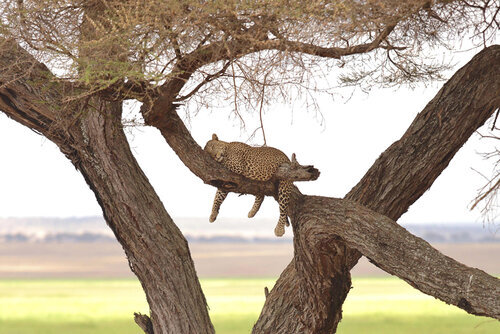TARANGIRE NATIONAL PARK
Tarangire’s relatively low tourist density makes this park a great addition to a safari through northern Tanzania.
The Tarangire River carves through wild, rugged terrain of vast swamplands, ancient baobabs, and massive termite mounds. During the dry season, the Tarangire River is a main water source for animals in the region. Massive herds of elephants and buffalo migrate through the park to this river and the vast Silale Swamp each year during the dry season.
Tarangire’s accessibility from Arusha can make the northern section of the park busy with day visitors during peak season, but a journey south provides a wild and remote safari experience. This special park is a hidden treasure along Tanzania’s northern safari circuit. Camps located in the central and southern section of the park provide a remote and memorable safari experience.
Seasons
Tarangire typically experiences two rainy seasons. The heavy rainy season lasts from March until May, and the short rainy season lasts from November to December. November’s rains occur at the end of a prolonged dry season and bring intermittent light showers, clear skies, and the return of migratory birds. This rainfall relieves Tarangire’s dry landscape and, if heavy enough, may fill seasonal swamps, providing alternative sources of water for animals.
Some camps in Northern Tanzania close during the heavy rains beginning in March when logistics become more difficult. Their reopening in May is marked by lush green grass, vibrant wildflowers, and swollen rivers that overflow into open swamplands. In June the region moves into the dry winter season with cooler temperatures, especially at night. By August, the dry season is in full effect. Massive herds of migrating mammals return to drink water from the Tarangire River and Silale Swamp.
Wildlife
While Tarangire is famous for high elephant densities, it is also home to resident buffalo, giraffes, zebras, lions, cheetahs, and leopards. Uncommon species like the bat-eared fox, gerenuk, and lesser kudu also live here. Tarangire is an open environment, where animals are free to migrate in and out. While its resident wildlife remains throughout the year, permanent water systems attract large numbers of elephants, wildebeests, and other migrating mammals during the prolonged dry season. Tarangire also boasts an amazing diversity of birds with 500 recorded species, as the swamplands and marshes provide an ideal breeding site!
Activities
Take a guided bush walk atop elephant footprints next to the Tarangire River and learn about the intricacies of this special ecosystem.
Walk to a remote campsite and spend a night under a blanket of stars in the middle of the African bush.
Take a night drive in the National Park in search of nocturnal species such as honey badger, aardvark, African wildcat, and larger predators such as hyena, leopard, and lion.
Hug an ancient baobab tree and realize its massive height and strength.
Accommodations
Check out some of our favorite accommodations in Tanzania’s Tarangire National Park.
Gallery
Ready to Plan?
Let’s Get Started



















